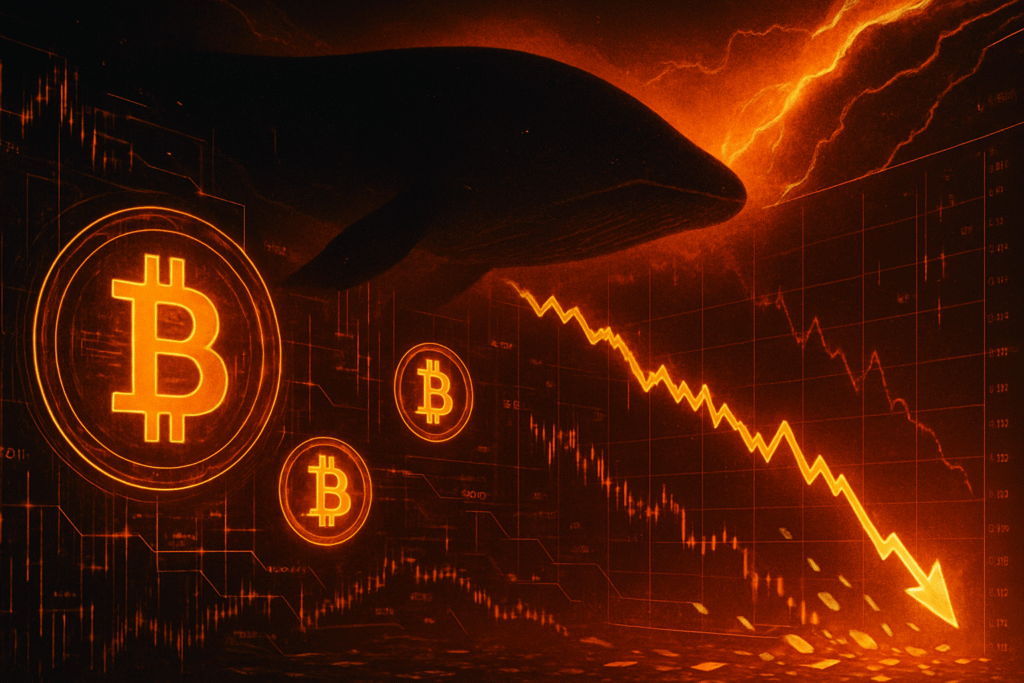
October 13, 2025 – The cryptocurrency market is reeling today after a mysterious "whale" investor, who reportedly profited handsomely from a recent "Trump tariff crash," significantly amplified their bearish bet on Bitcoin (BTC) by opening a new $127 million short position. This audacious move, coming on the heels of a historic market liquidation event, has ignited fierce debate across the crypto ecosystem, raising renewed concerns about market manipulation and the vulnerability of digital assets to large-scale, strategically timed trades.
The saga began to unfold on October 10, 2025, when former U.S. President Donald Trump, via Truth Social, announced plans to impose a sweeping 100% tariff on Chinese imports. This declaration sent shockwaves through global financial markets, and the cryptocurrency market bore the brunt of the immediate fallout. Bitcoin plummeted by over 8% from its highs, briefly touching lows around $102,000, while the broader crypto market witnessed an estimated $19 billion to $1 trillion wipeout in market capitalization, triggering the largest single-day liquidation event in crypto history, affecting over 1.6 million traders. Amidst this chaos, a particular whale, dubbed the "Trump Insider Whale," is reported to have opened substantial Bitcoin short positions days before the tariff announcement, specifically on October 6, 2025, netting an estimated $200 million in profit as the market crashed. Today, October 13, 2025, this same whale doubled down on their bearish stance, depositing an additional $40 million in USDC to the decentralized exchange Hyperliquid. This capital was used to open a new, leveraged Bitcoin short position valued at approximately $340 million, which included the specific $127 million BTC short mentioned in the query. This sequence of events has not only highlighted the market's extreme sensitivity to macroeconomic and geopolitical shifts but has also intensified scrutiny on the ethics and implications of such perfectly timed, large-scale trades.
Market Impact and Price Action
The market's reaction to the Trump tariff announcement on October 10, 2025, was nothing short of cataclysmic. Bitcoin, which had been trading above $125,000, plunged dramatically, briefly dipping below $102,000 on some exchanges, marking an intraday drop of approximately 16%. This represented an unprecedented $20,000 daily candle. Ethereum (ETH) suffered an even more severe percentage decline, plummeting from over $4,300 to roughly $3,373, an almost 18% intraday crash. Other major altcoins experienced widespread losses, with many falling between 15% and 60%, as panic selling gripped the market.
Trading volume spiked to extraordinary levels as a staggering $19.1 billion to $20 billion in leveraged positions were liquidated within 24 hours, overwhelming exchanges and causing significant liquidity issues. This historic liquidation event, affecting 1.6 million traders, dwarfed previous market shocks such as the 2020 pandemic crash and the FTX collapse in 2022. Market makers reportedly pulled quotes to manage risk, further thinning order books and exacerbating the flash crash. Technically, Bitcoin briefly breached the critical $100,000 support level, a move that analysts warned could signal the end of a multi-year bull cycle, though it found stabilization around $111,500.
The whale's subsequent increase in their short position on October 13, 2025, came as the market was attempting a fragile recovery. Despite the continued bearish pressure from the whale, Bitcoin swiftly reclaimed the $115,000 level, trading around $115,127.37, representing a nearly 3% surge in a single day post-crash. Ethereum also showed signs of recovery, settling around $3,795. This rebound was attributed to a softening geopolitical stance and robust institutional inflows, suggesting that while the initial crash was severe due to leverage and sudden panic, long-term fundamentals might still be perceived as strong by some market participants. However, the whale's renewed shorting activity has introduced a fresh layer of uncertainty, with their position already reportedly showing approximately $700,000 in unrealized profits shortly after being opened.
Community and Ecosystem Response
The crypto community's response to these events has been a volatile mix of alarm, speculation, and outrage. On social media platforms like X (formerly Twitter) and Reddit, discussions quickly centered on the uncanny timing of the whale's initial short position, just minutes or days before Trump's tariff announcement. Many users openly speculated about insider trading, with some labeling it "one of the biggest insider trades in history." Crypto influencers and on-chain analysts widely shared data highlighting the correlation between the whale's activity and the political news, leading to widespread accusations of market manipulation. While no official confirmation or direct link to insider sources has been established, and the alleged whale has reportedly denied insider trading, the perception of a "rigged" market has undoubtedly taken root in many corners of the community.
The massive liquidations sent shockwaves through the broader crypto ecosystem. Decentralized Finance (DeFi) protocols, particularly those reliant on over-collateralization, experienced significant stress as positions were rapidly liquidated. While many core protocols demonstrated resilience, the event highlighted potential vulnerabilities in oracle price feeds and liquidity pools during extreme volatility. NFT projects and Web3 applications, though less directly impacted by leveraged trading, saw a general downturn in sentiment and trading volume as investors de-risked across the board. The prevailing sentiment across crypto Twitter and Reddit has been one of heightened caution, with calls for greater transparency and improved regulatory oversight to prevent such perceived manipulation from eroding investor trust.
What's Next for Crypto
The recent market turmoil and the conspicuous whale activity present both immediate challenges and long-term implications for the crypto market. In the short term, increased volatility is likely to persist as the market digests the full impact of the geopolitical developments and continues to monitor the whale's substantial short position. Potential catalysts for further movement include any new statements regarding trade policies from global leaders, particularly the U.S. and China, as well as upcoming inflation reports and interest rate decisions from central banks. Investors will be closely watching for signs of sustained institutional inflows, which could provide much-needed buying pressure to stabilize the market.
Longer-term, this event could accelerate the ongoing maturation of the crypto space. Projects with robust fundamentals, strong communities, and transparent operations are better positioned to weather such storms, while those built on hype and excessive leverage may struggle. Strategic considerations for projects include strengthening treasury management, prioritizing core utility over speculative gains, and enhancing risk management in DeFi protocols. For investors, the emphasis remains on diversification, avoiding excessive leverage, and performing thorough due diligence. Possible scenarios range from a rapid V-shaped recovery, fueled by a quick resolution to geopolitical tensions and renewed institutional confidence, to a prolonged bear market characterized by investor apathy and a focus on building. A significant regulatory clampdown, prompted by concerns over market manipulation, also remains a distinct possibility, which could reshape the landscape for years to come.
Bottom Line
The events of October 2025 serve as a stark reminder of the inherent volatility and evolving risks within the cryptocurrency market. The Trump tariff announcement underscored crypto's sensitivity to macroeconomic and geopolitical shifts, demonstrating that digital assets, for now, largely behave as "risk assets" rather than true safe havens. The subsequent whale activity, with its perfectly timed short positions, has reignited long-standing concerns about market manipulation, information asymmetry, and the outsized influence of large players.
For crypto investors and enthusiasts, the key takeaways are clear: extreme caution with leverage, the critical importance of risk management, and the necessity of staying informed about both global economic trends and on-chain whale movements. The long-term significance of such events lies in their potential to erode investor confidence and attract heightened regulatory scrutiny. For crypto adoption to truly flourish, the industry must address these perceptions of manipulation through greater transparency, robust market surveillance, and a commitment to fair and equitable market practices. Important metrics to monitor moving forward include geopolitical developments, central bank policies, on-chain whale activity (exchange flows, large transactions), and key technical analysis indicators such as support/resistance levels and market sentiment indices.
This article is for informational purposes only and does not constitute financial or investment advice. Cryptocurrency investments carry significant risk.





